Caulophyllum thalictroides, commonly known as Blue Cohosh, is a perennial herb native to North America, particularly found in wooded areas of eastern and central regions.
It is widely recognized for its historical use as a woman’s remedy, particularly in conditions related to pregnancy and menstruation.
The plant has been used in traditional medicine by Indigenous peoples and later by herbalists for its diverse therapeutic properties.

Table of Contents
ToggleSOURCE INFORMATION
Scientific Classification
- Kingdom: Plantae
- Clade: Angiosperms
- Clade: Eudicots
- Clade: Rosids
- Order: Berberidales
- Family: Berberidaceae
- Genus: Caulophyllum
- Species: C. thalictroides
Origin and Historical Facts
- Blue Cohosh has been traditionally used by Native American tribes for various gynecological issues, including childbirth and menstrual disorders.
- It was considered an important herb in midwifery practices, especially to strengthen contractions and facilitate labor.
- The name “Caulophyllum” comes from the Greek words “caulos,” meaning “stem,” and “phyllon,” meaning “leaf,” reflecting the plant’s distinctive leaf structure.
DRUG PATHOGENESIS
- Caulophyllum acts primarily on the female reproductive system, promoting uterine contractions and addressing various menstrual and labor-related complications.
- It helps tone the uterus, reduces excessive menstrual flow, and alleviates symptoms of dysmenorrhea (painful menstruation).
- Additionally, its effects on the small joints suggest a role in addressing rheumatic conditions.
PHYSICAL CONSTITUTION
- Individuals who may benefit from Caulophyllum typically exhibit characteristics of uterine debility, such as excessive fatigue, irritability, and anxiety during menstruation or labor.
- They may have a sensitive constitution, prone to spasmodic pains and various forms of dysmenorrhea.
WHAT IS CONSTITUTION IN HOMOEOPATHY?
DIATHESIS
- Women with a history of habitual abortions or those experiencing uterine atony (lack of tone) are particularly responsive to Caulophyllum.
WHAT IS DIATHESIS IN HOMOEOPATHY?
TEMPERAMENT
- Women with a nervous or sensitive temperament, prone to anxiety and emotional stress during menstrual cycles or pregnancy, may benefit from this remedy.
WHAT ARE THE TYPES OF TEMPERAMENTS IN HOMOEOPATHY?
KEY CHARACTERISTICS
- Primarily affects the female reproductive organs and small joints.
- Characterized by spasmodic pain, rigidity of the cervix, and erratic joint pain.
DETAILED ORGAN SYMPTOMS
STOMACH
- Cardialgia: Burning or painful sensations in the stomach, often accompanied by spasms.
- Dyspepsia: General discomfort or difficulty in digesting food, characterized by bloating, nausea, or cramping.
FEMALE REPRODUCTIVE SYSTEM
- Labor: Effective in reviving labour pains when they are weak or absent, thus aiding in the progression of labour.
- Spasmodic Pains: Severe, erratic pains that may radiate throughout the body without leading to effective labour progress.
- Leucorrhoea: Excessive white discharge, sometimes accompanied by skin discoloration and “moth spots” on the forehead.
- Dysmenorrhea: Painful menstruation that radiates to various parts of the body, often described as needle-like pains in the cervix.
- Menstrual Issues: Prolonged lochia (postpartum discharge) and profuse menstruation or leucorrhoea.
SKIN
- Skin Discoloration: Notable changes in skin colour associated with menstrual and uterine disorders.
EXTREMITIES
- Joint Pain: Erratic and severe drawing pain and stiffness, especially in small joints such as fingers and toes.
- Aching Wrists: Pain in the wrists that may be exacerbated by movement, with cutting pains upon closing the hands.
MODALITIES
- Worse: During labour when pains are inadequate, and from anxiety or exhaustion.
- Better: Movement may provide some relief, particularly in cases of joint pain.
WHAT ARE MODALITIES IN HOMOEOPATHY?
RELATIONSHIPS WITH OTHER DRUGS
- Incompatible: Coffea (Coffee) can interfere with the action of Caulophyllum.
Compare with,
- Violet Odor: For rheumatic conditions involving the carpal and metacarpal joints.
- Cimicifuga: For menstrual and uterine issues.
- Sepia and Pulsatilla: For general female complaints and menstrual irregularities.
- Gelsemium: For associated symptoms of nervous tension.
DOSE
- Form: Tincture to third attenuation (dilution).
- The tincture can be prepared from the fresh plant or dried herb, typically administered in drop doses.
Frequently Asked Questions
What are the primary uses of Caulophyllum?
- Caulophyllum is primarily used to aid in labour, alleviate dysmenorrhea, and tone the uterus, making it a valuable remedy for women.
Is Caulophyllum safe during pregnancy?
- Caulophyllum is traditionally used during labour; however, it is important to consult a healthcare professional before use during pregnancy to ensure safety.
Can Caulophyllum help with menstrual irregularities?
- Yes, Caulophyllum is indicated for various menstrual issues, including excessive bleeding, painful periods, and uterine debility.
What should be avoided while taking Caulophyllum?
- Coffea (Coffee) should be avoided, as it can interfere with the effectiveness of Caulophyllum.
Meaning of Difficult Words
- Cardialgia: Pain in the region of the heart or stomach.
- Dyspepsia: Indigestion or discomfort in the upper abdomen.
- Leucorrhoea: A medical term for a thick, whitish or yellowish vaginal discharge.
- Atony: Lack of normal muscle tone or strength, often referring to the uterus after childbirth.
- Dysmenorrhea: Painful menstruation, often associated with cramps.
- Spasmodic: Characterized by spasms or sudden involuntary muscle contractions.
- Tonicity: The state of tension in muscles or tissues.
Caulophyllum thalictroides is a vital remedy for women’s health, particularly in managing conditions related to childbirth and menstruation.
Its historical significance and wide-ranging applications make it an essential component of homeopathic practice for those addressing gynaecological and rheumatic conditions.
